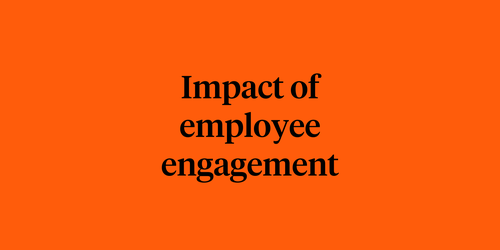
Written by

Former People Scientist, Culture Amp
Today, workplaces have moved toward being team-oriented environments. Workloads are interdependent and dispersed across employees, and we’ve seen great benefits to this shift.
Team structure helps companies achieve complex goals beyond one employee's capability alone. However, we must also consider the challenges that come along with this diffusion of responsibility. One main issue we've seen is employees being accountable for their work.
Workplace accountability is about following through and recognizing that other team members depend on your work's results. Each team member should take responsibility for their commitments, actions, and the consequences of their actions.
Workplace accountability is crucial for cultivating a culture of high performance. Internal research has demonstrated that high-performing employees are particularly attuned to the contributions of others. When team members aren’t contributing, this can impact a teammate’s desire to stay. For example, senior consultants with a global professional services firm were 1.7x more likely to leave when they perceived others weren’t being held accountable for delivering at work.
The question: Who is responsible for engagement?
When it comes to people and culture, who is truly responsible for driving things like engagement and organizational culture?
We’ve heard various perspectives that generally sit in two camps of thought. Some believe that people and culture initiatives are the responsibility of leadership or HR. Others believe “the people make the place". They feel that responsibility lies among individual employees tasked with shaping the organization's culture.
We believe there isn't one right way to determine who is responsible. There are pros and cons to each of these approaches.
Perspective #1: Individuals are responsible for their own engagement
Some researchers and practitioners believe that individuals are responsible for their own engagement. To a degree, being engaged is a choice.
Organizations can offer all the learning and development, coaching, support, and perks one could imagine, but if an employee does not want to utilize and benefit from them, they are unlikely to reap the benefits (i.e., feeling engaged at work). Further, employees can respond to the daily stressors they face at work in a productive or maladaptive way.
But of course, there are pros and cons to this perspective.
Pros
- Encourages individuals to participate in the engagement process. If you have a stake in the game and are responsible for your own experience, you are more likely to participate.
- Allows many voices to contribute to action planning. This approach encourages action planning at all levels of the organization, including our front-line employees. You’ll likely see a higher rate of follow-through on action plans when multiple people are responsible for them.
- Helps attract top talent. If we build a culture where individual employees are responsible for their engagement, you are more likely to recruit people with a higher sense of accountability (both for engagement and general workplace activities).
Cons
- Takes all responsibility off the organization. The reality is that things need to be done at the organizational level that contribute to employee engagement (e.g., learning and development opportunities and a transparent and fair performance management system).
- Fixed mindset. If we define employees as “highly accountable” or “less accountable,” we are insinuating that these are fixed traits that cannot be changed. The reality is that, as with many other things, levels of accountability tend to ebb and flow based on various factors.
- Can be weaponized. Saying that individuals are solely responsible for engagement can result in blaming employees for poor management or organizational practices rather than addressing systemic root causes of disengagement.
Perspective #2: Managers and organizations are responsible for employee engagement
Others believe that engagement is a top-down process – that only managers and the organization can truly take action and drive change.
As we identified above, there are things that the organization is responsible for and that employees have little to no influence over. But, again, there are some considerations to keep in mind.
Pros
- Ensures that action is taken. If managers and the organization are explicitly responsible for engagement, you are more likely to see action being taken in response to the results of an engagement survey.
- Makes the company culture first. Organizations that value engagement are those on the front line of employee experience practices. They are constantly working on creating a workplace culture that allows their employees to truly thrive.
Cons
- Takes all responsibility off the individual. If employees know they are not accountable for their workplace experience, they may simply divert any personal responsibility onto the organization.
- Learned helplessness. Your employees may feel like they have no control over their workplace experience.
- Managerial pressure. There is an added layer of pressure if management feels they have no support in taking action to drive change on their teams.
Incorporating a happy medium into your feedback strategy
So what does Culture Amp recommend regarding accountability for employee engagement? Take an approach that empowers individuals at all levels of the organization to be accountable.
This will encourage managers to empower employees to take action on the things they have control over (e.g., continuous learning) while simultaneously holding managers and the organization responsible for system-level impacts on individual-level experiences (e.g., poor resourcing).
Once you have outlined the roles and responsibilities of each organizational layer, you can embed your larger philosophy into all aspects of our organization. Initially, you’ll want to define what accountability looks like in your organization. Then you can ask questions on your engagement survey to measure this throughout the employee lifecycle.
Finally, you can empower all levels of your organization to take action based on your survey results. The reality is that individuals, departments, managers, and the organization are responsible for creating an engaging experience in the workplace.



